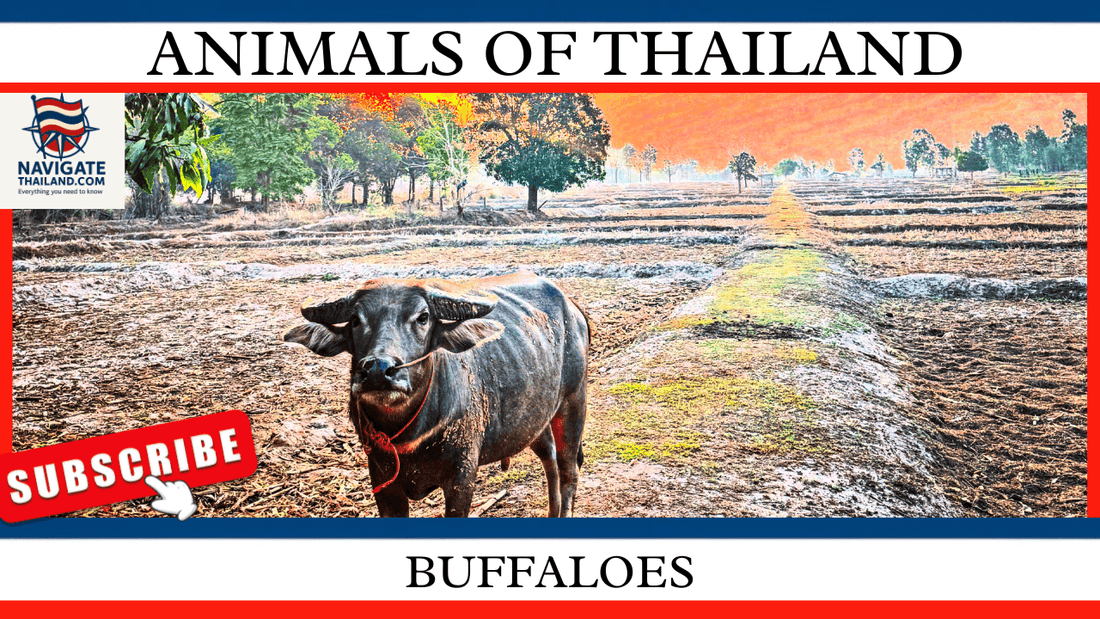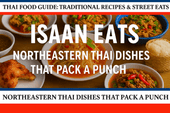
Thai Buffalo: From Farm Workers to Culinary Delights
Share
Buffaloes have long been an integral part of rural life in Thailand, contributing to agriculture, culture, and cuisine in various ways. From laboring in rice paddies to providing meat and milk, these majestic creatures have earned their place as invaluable assets to Thai farmers. Moreover, buffalo races and fights are still popular traditions in some regions, showcasing the strong cultural ties between these animals and the people of Thailand. In this article, we'll explore the different types of buffaloes in Thailand, their uses in farming, their role in food production, and the traditional buffalo-related events that are still celebrated today.
## Types of Buffalo in Thailand
The buffalo most commonly found in Thailand is the **Swamp Buffalo** (Bubalus bubalis), known locally as "Kwai." These animals are well adapted to the wet and muddy environment of the country’s rice paddies. However, **River Buffalo** (Bubalus arnee), though less common, can also be found in some parts of Thailand, especially in regions near the border with Laos and Cambodia. Each type of buffalo has slightly different characteristics and uses.
### 1. **Swamp Buffalo**
The Swamp Buffalo is the dominant breed in Thailand. Known for its large, stocky frame and curved horns, this species is well-suited to plowing rice fields and other heavy farm labor due to its ability to wade through muddy waters without difficulty.
- **Native Territory**: Swamp buffaloes are typically found across the Central, Northeast, and Northern regions of Thailand, where rice farming is prevalent.
- **Characteristics**: They are usually gray or black, with coarse skin and wide hooves adapted for the swampy terrain of rice paddies.
- **Uses**: These buffaloes are mainly used for heavy labor, but they are also valued for their meat, which has become increasingly popular in Thai cuisine.
### 2. **River Buffalo**
The River Buffalo is less common in Thailand but is still found in some areas. It is smaller and leaner than the Swamp Buffalo, with straighter horns and lighter skin. River buffaloes are typically used in regions where irrigation systems rely more on rivers than on flooded paddies.
- **Native Territory**: The River Buffalo can be found in Thailand’s southern provinces and near the borders with Laos and Cambodia, where water bodies are more common.
- **Characteristics**: They are lighter in color, often with a bluish-gray tint, and are better suited to drier environments than their swamp-loving cousins.
- **Uses**: These buffaloes are often used for dairy production in other parts of Southeast Asia, but in Thailand, their use is generally confined to work and meat production.
## Buffalo as Farm Workers
For centuries, buffaloes were the backbone of Thai agriculture, particularly in rice cultivation. They are prized for their strength and stamina, which make them ideal for plowing fields, especially in wet, muddy conditions that would be challenging for most other farm animals or machinery. The buffalo’s significant contribution to traditional Thai farming cannot be overstated.
### 1. **Plowing and Soil Preparation**
Buffaloes are used to pull heavy plows through waterlogged rice fields, loosening the soil before planting. Their wide hooves prevent them from sinking into the mud, making them more effective than machines in certain terrains. In remote areas or among farmers who practice traditional methods, buffaloes are still preferred over tractors for this reason.
### 2. **Transport**
In the past, buffaloes were also used to transport goods and produce, often pulling carts loaded with rice, sugarcane, or other crops. While motorized vehicles have largely replaced this practice, some rural communities still rely on buffalo power, particularly in hard-to-reach areas.
### 3. **Fertilization**
Buffaloes not only help in farming tasks but also contribute to soil fertility. Their manure is collected and used as organic fertilizer, enriching the soil with essential nutrients for rice paddies and other crops.
## Buffalo in Thai Cuisine
While buffaloes were traditionally used as farm animals, their role in Thai cuisine has grown over time. Buffalo meat, known as "Nuea Kwai," is prized for its rich, gamey flavor and lean texture, making it a popular choice in various regional dishes.
### 1. **Buffalo Meat**
Buffalo meat is tougher and leaner than beef, making it ideal for slow-cooked stews and grilled dishes. In regions like Isaan in Northeast Thailand, buffalo meat is frequently used in spicy salads, such as **larb kwai** (spicy minced buffalo salad), and grilled over open flames to make **yang kwai** (grilled buffalo meat).
- **Popular Dishes**:
- **Larb Kwai**: A spicy salad made from minced buffalo meat, mixed with lime juice, chili, and herbs.
- **Yang Kwai**: Grilled buffalo meat served with sticky rice and a side of spicy dipping sauce.
- **Kaeng Kwai**: A slow-cooked buffalo curry that tenderizes the meat, infusing it with spices and rich flavors.
### 2. **Buffalo Milk and Dairy Products**
While buffaloes are not typically raised for their milk in Thailand, their dairy products, such as **buffalo milk cheese** (including mozzarella), are more common in other Southeast Asian countries. Buffalo milk is rich in fat and used in making cheese, yogurt, and other dairy products in regions where River Buffaloes are more common.
## Buffalo Fights and Races: Cultural Events
Buffaloes are not only valuable in farming and cuisine but also play a central role in local festivals and traditions. In some Thai provinces, particularly in the South and Northeast, buffalo races and fights are major annual events that draw crowds of spectators.
### 1. **Buffalo Fights**
Buffalo fights, particularly popular in the Southern region of Thailand, are organized during festivals and religious events. Two male buffaloes are pitted against each other, and the animals lock horns until one retreats or is too tired to continue. These fights are highly ceremonial and reflect the buffalo’s historical role as a symbol of strength and power.
- **Cultural Significance**: The fights are often seen as symbolic displays of courage and resilience, traits that are highly valued in Thai culture. Despite controversy over animal rights, buffalo fighting remains a popular tradition in certain areas.
### 2. **Buffalo Races**
One of Thailand’s most unique cultural events is the annual **Buffalo Racing Festival** held in Chonburi, east of Bangkok. Here, young men ride bareback on buffaloes, racing them down a dirt track. The event is both thrilling and dangerous, as buffaloes are known for their speed and unpredictability.
- **Cultural Significance**: The festival, which coincides with the end of the rice harvest season, is a way for farmers to showcase the strength and agility of their buffaloes. Prizes are awarded not only for the fastest buffaloes but also for the most beautifully decorated animals.
## Types of Buffalo Farming in Thailand
Buffalo farming in Thailand has evolved from traditional subsistence practices to a more commercial enterprise, driven by the growing demand for buffalo meat and the rise of sustainable, small-scale farming initiatives.
### 1. **Subsistence Farming**
Traditionally, buffalo farming was an essential part of rural life, with each household owning at least one buffalo to assist with agricultural tasks. These buffaloes were integral to the family's livelihood, working the fields and providing food and income. In many villages, the ownership of a buffalo was a sign of wealth and status.
### 2. **Commercial Buffalo Farming**
In recent years, buffalo farming has seen a resurgence, as the demand for buffalo meat has increased both locally and internationally. Buffalo farms are now being developed for the sole purpose of raising buffaloes for meat production, with some also focusing on milk and dairy products.
### 3. **Sustainable Buffalo Farming**
Sustainable buffalo farming practices are gaining popularity, particularly in Northern Thailand, where farmers are working to raise buffaloes in a way that supports both the environment and the local economy. These farms prioritize animal welfare, organic farming practices, and the preservation of Thailand’s agricultural heritage.
## The Decline of Buffalo in Thai Agriculture
Despite their historical importance, buffalo populations in Thailand have sharply declined over the past few decades. The introduction of mechanized farming equipment like tractors and motorized plows has reduced the need for buffalo labor, and many farmers have opted to sell their buffaloes to meet financial needs. However, there are efforts to preserve buffalo farming, as they remain an important part of Thai rural culture and contribute to sustainable agricultural practices.
## Conclusion
Buffaloes have been vital to the history, culture, and economy of Thailand for centuries. From their traditional roles as farm laborers and transportation aids to their current place in food production and cultural festivals, buffaloes are inseparable from Thai life. While their roles have evolved over time, these resilient animals continue to be revered in many parts of the country. Whether laboring in rice fields, providing delicious meat, or starring in a thrilling buffalo race, the Thai buffalo remains a symbol of strength, endurance, and cultural pride.
---
## References:
1. Lair, R. C. (1997). **Gone Astray: The Care and Management of the Asian Elephant in Domesticity**. FAO.
2. Baker, C., & Phongpaichit, P. (2009). **A History of Thailand**. Cambridge University Press.
3. Lekagul, B., & McNeely, J. A. (1977). **Mammals of Thailand**. Association for the Conservation of Wildlife.
4. Kaosa-ard, M., & John, L. (1996). **The Water Buffalo in Asia**. International Development Research Centre.
5. Robinson, W. C., & Kloss, C. B. (1921). **The Mammals of Southeast Asia**. Smithsonian Institution
Read more of our Thailand blog series:
Thai Food Guide:Traditional Recipes and Street Eats
Everything Travellers Need to know
Thailand travel ebooks and language guides
Thailand Travel Apparel & Souvenir Gifts
Subscribe to our YouTube channel Navigate Thailand to see our most popular Thailand travel blogs turned into videos:
Navigate Thailand YouTube channel




















































































































































